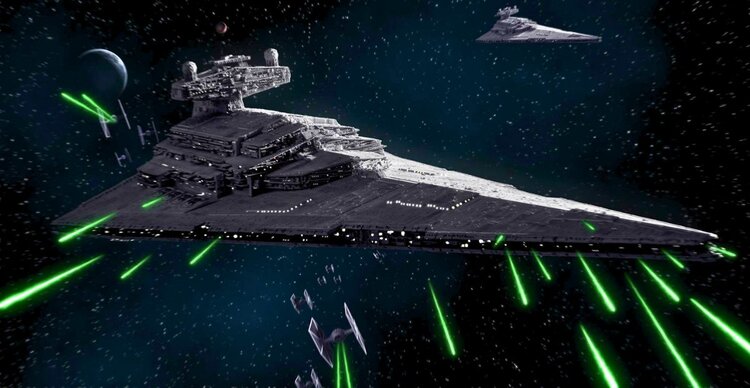Wait… has anyone actually thought about this? When a TIE Fighter misses, where does that laser even go? Like, does it just keep flying? Is there a random blaster bolt still drifting through space from some battle decades ago?
Because space doesn’t have walls, it’s not like it just stops. So theoretically, there could be thousands of stray shots just cruising around out there. Imagine being some pilot minding your own business and suddenly zap, vaporized by a laser fired before you were even born.
Do they fizzle out? Do they hit something? Or are there entire planets out there covered in burn marks from random space battles nobody remembers?
We’ll never know. But somewhere in the galaxy, a stormtrooper’s missed shot might still be traveling… and honestly, that’s kind of hilarious.
They’re Not Really Lasers
Before we can figure out where those “lasers” actually go, we first need to understand what they really are. Because if you’re like most of us, you probably assumed that ships in Star Wars were literally shooting lasers, right? Bright beams of light, cutting through space like something straight out of a sci-fi textbook.
But not quite.
What we see in the movies aren’t lasers at all — they’re blaster bolts. And blasters, according to Lucasfilm’s official description, are “ranged energized particle weaponry.” In simple terms, that means they don’t shoot light, but bursts of superheated plasma — charged particles wrapped in a magnetic field and fired at high velocity.
That’s also why we can actually see them move. If they were true lasers, you’d never see the beam travel — it would just hit instantly. But blaster bolts move slower, almost like glowing bullets but slower. They’ve got weight, momentum, and a lifespan. The energy that holds them together isn’t endless, and as they fly through space, that magnetic field begins to break down.
Even in the vacuum of space, there’s still dust, gas, and debris. Every time those energized particles hit something, even tiny matter, they lose a bit of energy. Over time, that energy weakens, the plasma cools, and the bright bolt we see on screen eventually fades out completely.
So when a TIE Fighter misses its target, that red streak doesn’t go flying across the galaxy forever — it just burns itself out somewhere along the way, leaving nothing but a faint trail of ionized gas behind.
How Far Could a Blaster Bolt Actually Go?
Alright, so if blaster bolts don’t travel forever, how far do they go before fizzling out?
That’s the tricky part, we don’t get an official number in canon, but we can make a solid guess. Since blasters fire magnetically contained plasma, the range depends on how long that containment field can hold before the energy breaks apart. In the vacuum of space, that might sound like a long distance — no air resistance, no gravity to pull it down, but the bolt still loses power every second it flies.
In The Essential Guide to Warfare, blasters are said to lose their cohesion after just a few kilometers. They can look bright and deadly at first, but the energy that keeps the plasma together fades quickly once it’s released. A starfighter-grade cannon might push farther than a handheld blaster, but even then, we’re not talking light-years, more like a few dozen kilometers before it’s nothing more than glowing gas.

So next time you see an X-wing miss a shot in space, don’t worry — that bolt isn’t heading off to ruin some poor alien’s day on the other side of the galaxy. It’s probably burned itself out long before it even clears the battle zone.

